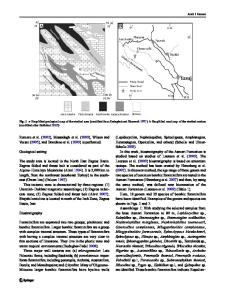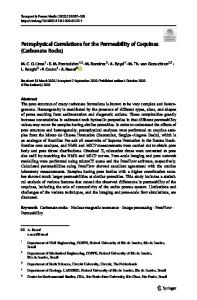Petrography of carbonate rocks in the Asmari Formation, Zagros Basin, Dezful Embayment and Izeh Zone, SW Iran
- PDF / 12,483,178 Bytes
- 15 Pages / 595.276 x 790.866 pts Page_size
- 43 Downloads / 315 Views
ORIGINAL PAPER
Petrography of carbonate rocks in the Asmari Formation, Zagros Basin, Dezful Embayment and Izeh Zone, SW Iran Mahnaz Dehghanzadeh 1 & Mohammad Hossein Adabi 1 Received: 26 November 2019 / Accepted: 13 August 2020 # Saudi Society for Geosciences 2020
Abstract This research aims at studying the Oligo-Miocene Asmari Formation, which is known as one of the best oil reservoirs in Iran. For better understanding and comparing the trend of lithological changes and depositional environment of this formation in a wider area, 5 sections were selected which consist of Lali 20, Karun 3, Masjed Soleyman 186 subsurface, and Asmari anticline surface sections in Dezful Embayment and Gurpi anticline surface section in Izeh Zone. Using polarizing and cathodoluminescence microscopic studies, diagenetic processes affecting the Asmari and their paragenetic sequence in the study areas were interpreted. Index diagenetic processes that have affected the Asmari Formation carbonate rocks include micritization, bioturbation, boring, cementation (such as marine, meteoric, and burial cementation), dissolution (meteoric and burial dissolution), dolomitization (in different phases), pyritization, hematitization, silicification, mechanical and chemical compaction, and fracturing. In general, diagenetic processes such as dissolution and fracturing have increased the reservoir quality, while cementation and compaction have decreased the reservoir potential of this formation. Cathodoluminescence studies indicate three generations of cement of marine, meteoric, and burial based on the color contrast. Keywords Asmari Formation . Petrography . Dezful Embayment . Izeh Zone . Zagros Basin
Introduction Petrography is an especially powerful tool because it enables the identification of constituent grains, the detailed classification of sediments and rocks, the interpretation of environments of deposition, and the determination of the often complex history of postdepositional alteration (diagenesis) (Scholle and Ulmer-Scholle 2006). Diagenesis is the most crucial factor impacting reservoir property (Salem et al. 2005; Honarmand and Amini 2012). Hence, reconstruction of the diagenetic history is important in understanding reservoir porosity and permeability to predict the reservoir characteristics of rocks (Baiyegunhi et al. 2017).
Responsible Editor: Domenico M. Doronzo Electronic supplementary material The online version of this article (https://doi.org/10.1007/s12517-020-05855-0) contains supplementary material, which is available to authorized users. * Mahnaz Dehghanzadeh [email protected] 1
Faculty of Earth Sciences, Shahid Beheshti University, Evin, Tehran, Iran
Despite many studies on the Asmari Formation as one of the most important reservoirs in southern Iran, there is still no comprehensive information on the physical and chemical conditions of this formation. This research aims at investigating the main diagenetic processes and their effects on the formation to achieve reservoir quality controlling factors and depos
Data Loading...











